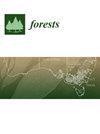Improving Tree Cover Estimation for Sparse Trees Mixed with Herbaceous Vegetation in Drylands Using Texture Features of High-Resolution Imagery
IF 2.4
2区 农林科学
Q1 FORESTRY
引用次数: 0
Abstract
Tree cover is a crucial vegetation structural parameter for simulating ecological, hydrological, and soil erosion processes on the Chinese Loess Plateau, especially after the implementation of the Grain for Green project in 1999. However, current tree cover products performed poorly across most of the Loess Plateau, which is characterized by grasslands with sparse trees. In this study, we first acquired high-accuracy samples of 0.5 m tree canopy and 30 m tree cover using a combination of unmanned aerial vehicle imagery and WorldView-2 (WV-2) imagery. The spectral and textural features derived from Landsat 8 and WV-2 were then used to estimate tree cover with a random forest model. Finally, the tree cover estimated using WV-2, Landsat 8, and their combination were compared, and the optimal tree cover estimates were also compared with current products and tree cover derived from canopy classification. The results show that (1) the normalized difference moisture index using Landsat 8 shortwave infrared and the standard deviation of correlation metric calculated by means of gray-level co-occurrence matrix using the WV-2 near-infrared band are the optimal spectral feature and textural feature for estimating tree cover, respectively. (2) The accuracy of tree cover estimated using only WV-2 is highest (RMSE = 7.44%), indicating that high-resolution textural features are more sensitive to tree cover than the Landsat spectral features (RMSE = 11.53%) on grasslands with sparse trees. (3) Textural features with a resolution higher than 8 m perform better than the combination of Landsat 8 and textural features, and the optimal resolution is 2 m (RMSE = 7.21%) for estimating tree cover, whereas the opposite is observed when the resolution of textural features is lower than 8 m. (4) The current global product seriously underestimates tree cover on the Loess Plateau, and the tree cover calculation using the canopy classification of high-resolution imagery performs worse than the method of directly using remote sensing features.利用高分辨率图像的纹理特征改进旱地稀疏树木与草本植被混合的树木覆盖率估算
林木覆盖是模拟中国黄土高原生态、水文和水土流失过程的重要植被结构参数,尤其是在 1999 年实施 "绿色粮食 "项目之后。然而,目前的树木覆盖产品在黄土高原的大部分地区表现不佳,因为黄土高原的特点是草地和稀疏的树木。在这项研究中,我们首先利用无人机图像和 WorldView-2 (WV-2) 图像获取了 0.5 米树冠和 30 米树木覆盖的高精度样本。然后,利用从 Landsat 8 和 WV-2 获得的光谱和纹理特征,采用随机森林模型估算树木覆盖率。最后,对使用 WV-2、Landsat 8 和它们的组合估算的树木覆盖率进行了比较,并将最优树木覆盖率估算结果与当前产品和树冠分类得出的树木覆盖率进行了比较。结果表明:(1)使用 Landsat 8 短波红外波段的归一化差异水分指数和使用 WV-2 近红外波段的灰度共现矩阵计算的相关度量标准偏差分别是估算树木覆盖率的最佳光谱特征和纹理特征。(2) 在树木稀疏的草地上,仅使用 WV-2 波段估计树木覆盖率的精度最高(RMSE = 7.44%),这表明高分辨率纹理特征比大地遥感卫星光谱特征(RMSE = 11.53%)对树木覆盖率更敏感。 (3) 分辨率高于 8 米的纹理特征比大地遥感卫星 8 和纹理特征的组合表现更好,最佳分辨率为 2 米(RMSE = 7.(4) 目前的全球产品严重低估了黄土高原的树木覆盖率,利用高分辨率图像的树冠分类计算树木覆盖率的效果比直接利用遥感特征的方法差。
本文章由计算机程序翻译,如有差异,请以英文原文为准。
求助全文
约1分钟内获得全文
求助全文
来源期刊

Forests
FORESTRY-
CiteScore
4.40
自引率
17.20%
发文量
1823
审稿时长
19.02 days
期刊介绍:
Forests (ISSN 1999-4907) is an international and cross-disciplinary scholarly journal of forestry and forest ecology. It publishes research papers, short communications and review papers. There is no restriction on the length of the papers. Our aim is to encourage scientists to publish their experimental and theoretical research in as much detail as possible. Full experimental and/or methodical details must be provided for research articles.
 求助内容:
求助内容: 应助结果提醒方式:
应助结果提醒方式:


